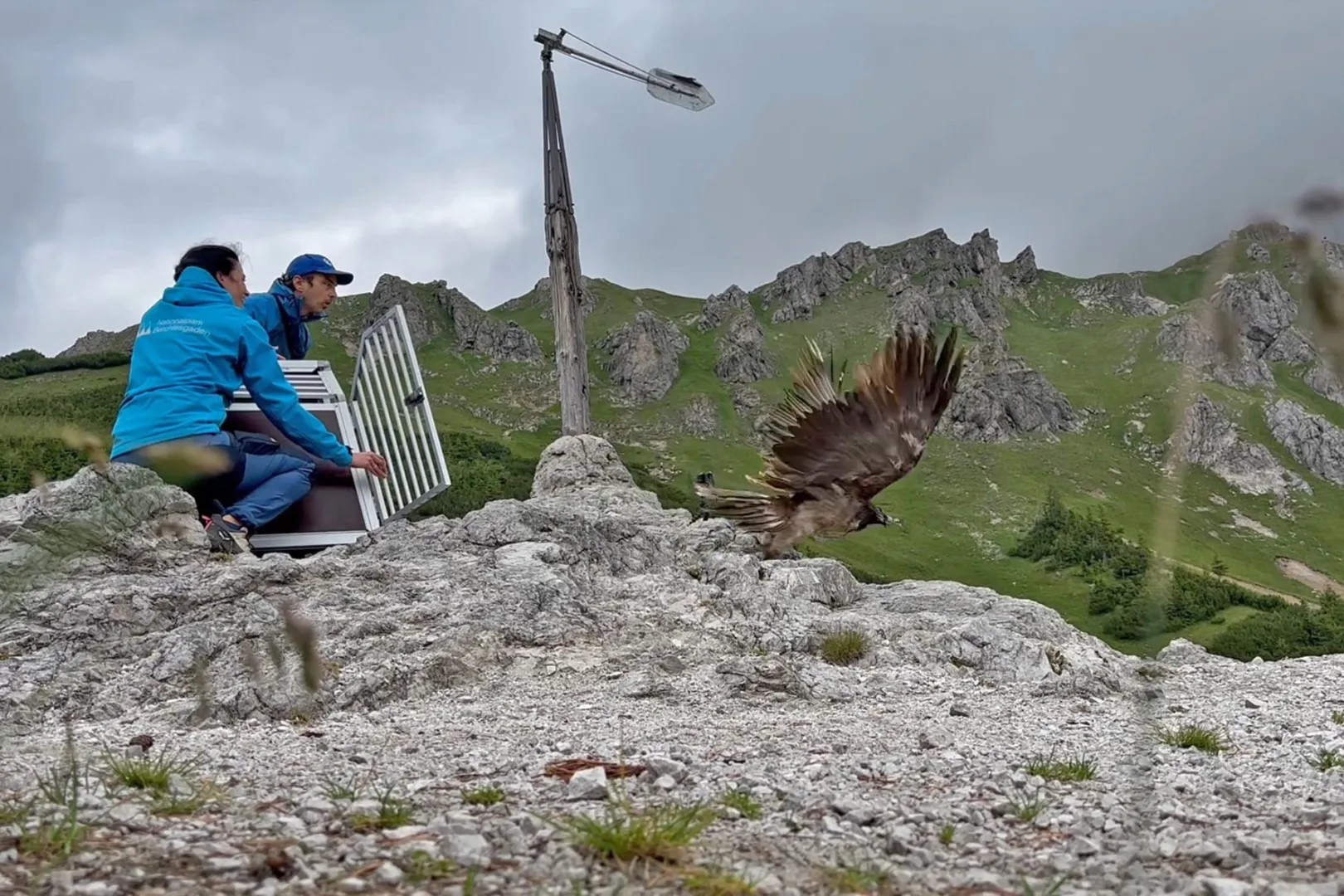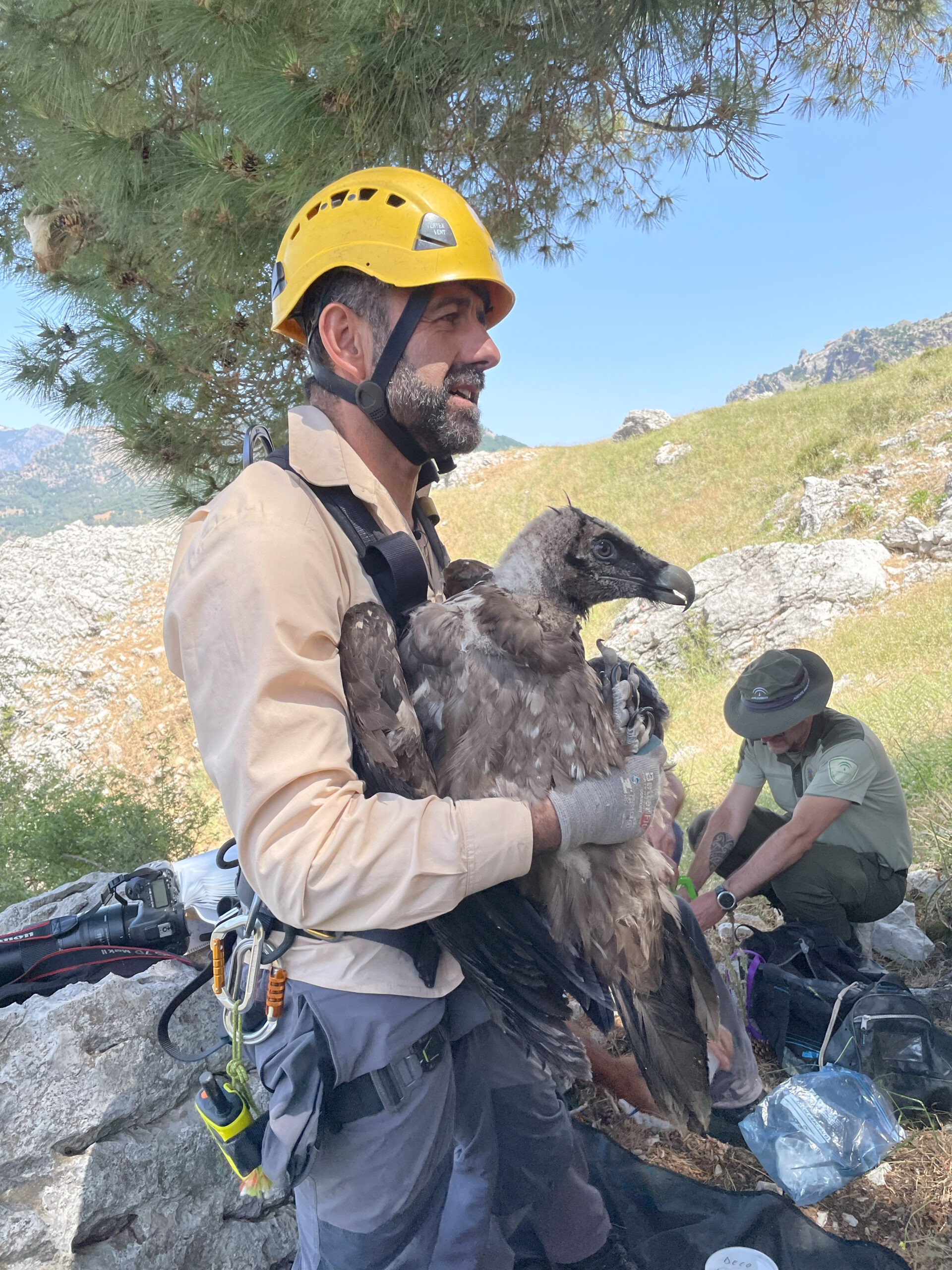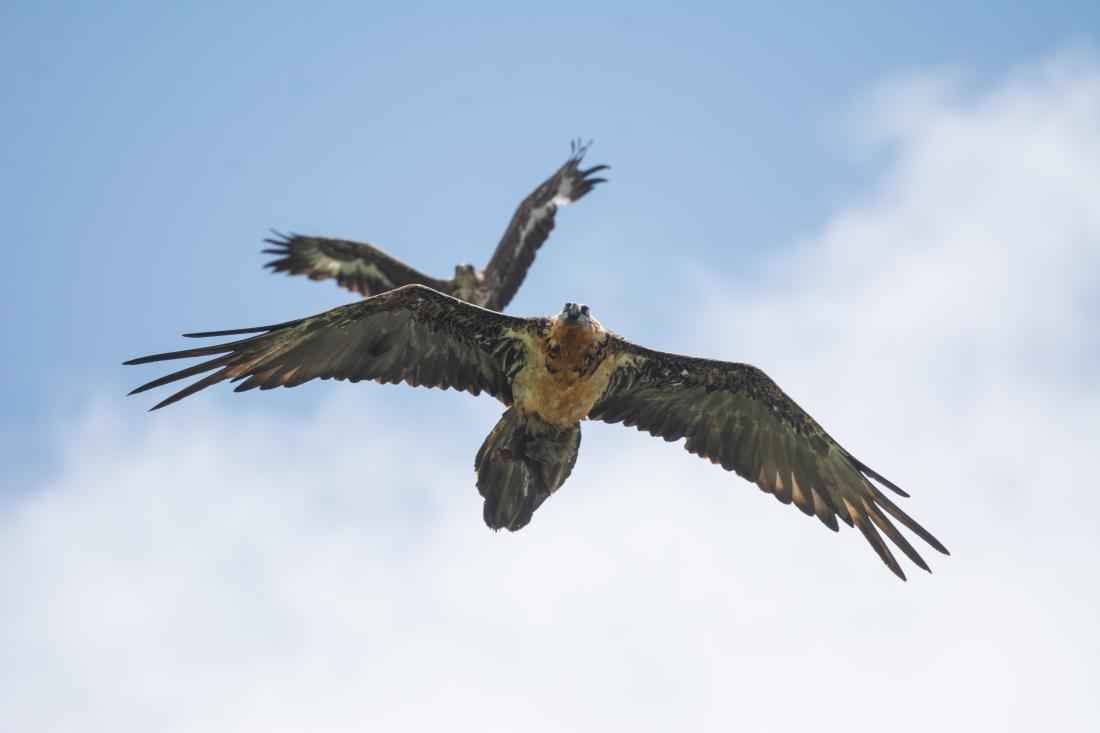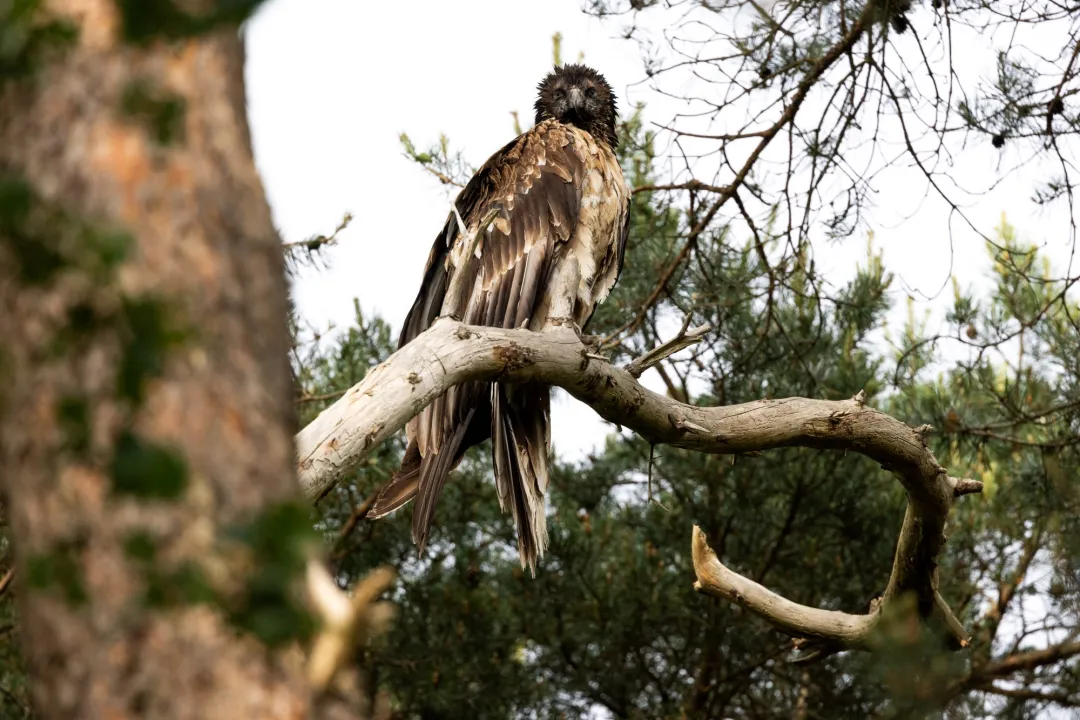With the release of “Tiscar” in Cazorla in the last week of June, the Bearded Vulture (Gypaetus barbatus) release season 2024 has successfully come to an end. With tireless efforts and strong collaboration between everyone within the EEP network, 53 chicks hatched of which 44 fledged and 24 birds were released into the wild in Europe.
This was an exceptional season for captive breeding as well as reintroduction and restocking efforts, reaching an all-time high in the number of chicks hatched and released within one season – a result worth celebrating!
We are happy to see many of the released vultures already soaring in the skies and bringing us one step closer to bringing back this magnificent species back to Europe from the brink of extinction.

Exceptional Bearded Vulture Captive Breeding Season
This was truly a great season for Bearded vulture captive breeding and releases which we at VCF coordinate through the Bearded Vulture captive breeding network for EAZA’s European Endangered Species Programme (Bearded Vultures EEP). This network includes over 40 zoos, private collections, and specialized breeding centers in Europe which we collaborate with ensuring all partners adhere to EEP guidelines to achieve optimal breeding results.
This season, not only the all-time record for the whole Bearded Vulture captive breeding network was broken. In addition to that, one of the most significant facilities within the network, Richard Faust Center in Haringsee Austria, broke the world record of highest-ever number of Bearded Vulture chicks produced in a single breeding season with 18 eggs laid of which 15 chicks hatched.
Of the 53 chicks hatched within the network, 44 fledged, 24 were released and 20 remained in the EEP for breeding purposes. In addition, there are three chicks with special cases – one is blind (Julia in Guadalentín) and will act as a species ambassador for educational activities, while two are outside of the EU and difficult to import.
Bearded Vulture Release Season 2024
Here’s a little recap of the season, along with some latest updates of the released birds.
–3 May 2024 – Oeil rouge “Red Eye” from Richard Faust Centre, Austria was released in Baronnies, France, as part of the LIFE GypACT project.

Oeil Rouge was one of the first two birds releases this season, keeping the monitoring team busy since the very beginning. First, he had a meeting with a fox just one day after the release (luckily nothing bad happened).Then, he decided to take his first flights at 107 days old and later got himself recaptured twice due to difficult weather conditions. Despite the challenges, Oeil Rouge is now doing well and exploring his new habitat in Southern France.
–3 May 2024 – Merivilha “Wonder” from Ostrava Zoo, Czech Republic, was released in Baronnies, France, as part of the LIFE GypACT project.

Even though released at the same time, Merivilhas start in the wild was a lot less dramatic than of his brother Oeil Rouge. Her development has been steady and the bird is enjoying her new life in the Leoux Valley in Baronnies.
–13 May 2024 – Torreferrussa from Torreferrussa Wildlife Center, Spain was released in Cazorla, Spain.

The story of young Torreferrussa is the most heartbreaking of this season. The release went well but unfortunately only 10 days after her release, a fox managed to enter the cave and killed Torreferrussa. Despite our efforts to prevent such incidents—with the hacking cave located in a remote area and protective fencing designed to keep out terrestrial predators—wildlife can still surprise us and provide teaching moments.
-13 May 2024 – Alfranca from Centro de Cría en Aislamiento Humano (CRIAH) in La Alfranca, Zaragoza in Aragón, Spain, was released in Cazorla, Spain.

Alfranca, luckily survived the fox incident without any harm and has continued to develop well. Just recently, she took her first flights and is now soaring the skies of Andalusia.
–13 May 2024 – Tornado, from Guadalentín Breeding Centre in Andalusia, was released in Grands Causses, France, as part of the LIFE GypACT project.

Even though Tornado took a little longer to adapt to her new environment, naps in the sun and delicious lamb feet snacks powered her first flight on 18 June at 7:30 am, when she was 125 days old. After two days of hesitation, Tornado made a graceful glide of about a hundred metres, landing below the ledge on a grassy slope. Now, she explores her new environment, practicing her flights to live up to her powerful name.
–13 May 2024 – Terre, also from Guadalentín, was released in Grands Causses, France, as part of the LIFE GypACT project.

Terre adapted quickly to her new environment, initially keeping herself busy with the culinary delights of French cuisine and spending most of her days eating. On 18 June, at 131 days old, she took her first flight in the afternoon, just a few hours later than her “sister” Tornado. Despite a strong wind, she beautifully glided to the surrounding cliffs to the east.
–27 May – Fuego from Guadalentín Breeding Centre, Spain, was released in Vercors, France, as part of the LIFE GypACT project.

Fuego’s life began in a very dramatic situation as her egg had a thin shell and two significant fractures along its main axis, which cast doubt among the staff about the chick’s chances of survival. To everyone’s amazement, Fuego defied the odds. Despite needing help to hatch, she began to grow and develop normally, and her life in the wild in Southern France has been a success.
-27 May 2024 – Boreale, also from Guadalentín Breeding Centre, Spain, was released in Vercors, France, as part of the LIFE GypACT project.

Just days after Fuego began its journey, another chick named Boreale hatched – also not without drama. Boreale was left half-buried and alone in her parents’ nest at 4 am. Just 20 minutes later, staff rescued Boreale from the cold and moved it to the warmth of the Guadalentín centre’s lab. Boreale continued to thrive and after 83 days, she was ready to be released and has been developing well ever since.

-29 May 2024 – Vinzenz from Richard Faust Centre, Austria, was released in Berchtesgaden, Germany.

From the very beginning since his release, Vinzenz was extremely committed to practicing his wing beats. Therefore, it was no surprise that he was the first one to take off from the two males that were released together. On a crisp morning on 30 June 2024, Vinzenz took off into the air with a few powerful wing beats and elegantly soared out of the fenced-in rock niche (see video of his first flight).
Vinzenz has already discovered one of the feeding places set up by the team and is also proving to be an exceptionally good flier. In the first few days after his first flight, he was already circling far around the release region and parried an aerial attack by a golden eagle with astonishing agility.
–29 May 2024 – Wiggerl from Korkeasaari Zoo, Finland, was released in Berchtesgaden, Germany.

Since the release, Wiggerl has already managed to survive from getting himself in trouble quite a few times. A few weeks ago, before he was able to fly, a small but completely normal argument broke out between the two young birds. During an evasive maneuver, bearded vulture Wiggerl fell backwards over the edge of the rock out of the niche and 30 meteres down into steep terrain. Luckily, he was unharmed. Only a short time after the fall, the project team from LBV and Berchtesgaden National Park brought Wiggerl safely back into the fenced niche.
Five days after the first flight of Vinzenz, Wiggerl also took his first flight. (Watch the video) Wiggerl took off from the fenced-off rock niche in the Klausbach valley, soared off like a pro and mastered his first flight very well. However, his first landing was not appreciated by a chamois standing nearby. (See video of the encounter). Visibly irritated by Wiggerl’s appearance, the chamois launched a half-hearted attack with its horns. Wiggerl, untouched, immediately flew away and landed safely on a rock.
-4 June 2024 – Gea from Liberec Zoo, Czech Republic, from was released in Maestrazgo, Spain.

Gea was released with two other “sisters”, Guaita and Genista, and has quickly adapted to her new life in Spain.
–4 June 2024 – Guaita from our breeding centre in Guadalentín, Spain released in Maestrazgo, Spain.

Guaita was the first one of the three females to leave her nest and start flying. She was caught by a camera in Maestrazgo during her lunch time on the first of July.
-4 June 2024 – and Genista from Alpenzoo Innsbruck, Austria was released in Maestrazgo, Spain.
The “Innsbruck chick” is called Genista and is descended from the Bearded Vulture couple Romeo and Juliet. Already as a chick she captured the hearts of the Alpenzoo staff and visitors who have followed her development in Spain with joy and anticipation.

– 4 June 2024 – Piuma from Richard Faust Breeding Centre in Haringsee, Austria, was released in Corsica as part of the LIFE GypRescue project.

Piuma (Feather) received her name from the local school children and the kids welcomed her on the island with open arms.
–4 June 2024 – Culomba also comes from Richard Faust Breeding Centre in Haringsee, Austria, and was released in Corsica as part of the LIFE GypRescue project.

She also was warmly welcomed by the community and is adapting well into her new surroundings. Culomba took her first flight on 3 July and is now soaring in the skies of Corsica.
–6 June 2024 – Gaia from Torreferrussa Wildlife Centre in Spain was released in Melchsee-Frutt, Switzerland.

On 24 June, Gaia spent her first night outside the release niche. The next day, she climbed back in, drank, ate, and did some flight exercises before taking her first flight at 125 days old. Gaia’s first flight lasted 15 seconds. After a half-hour rest, she made her second successful flight, followed by two more. On her fourth flight, she was pursued by an almost fully grown Bearded Vulture, but managed to land safely.
-6 June 2024 – Paradiso from Beauval Zoo in France was released in Melchsee-Frutt, Switzerland.

Paradiso was released together with two females Gaia and Aurora and the three are getting along well, even sharing the nest from time to time. On 12 June Paradiso took off on his first flight. He flew for about 30 seconds, made a nice turn and landed safely near the release niche. Paradiso has continued to diligently practice his flying technique and has already become a very good flier.
–6 June 2024 – Aurora from Richard Faust Zentrum Specialized Breeding Centre in Austria was released in Melchsee-Frutt, Switzerland.

Aurora, the youngest of the three, took her first flight on 6 July. At 6 a.m., the monitoring team couldn’t find her despite searching everywhere. Just as worry set in, Aurora was spotted flying beautifully over the release niche (See video here). She had climbed over the fence and escaped, and then made her first flight straight back towards the “breakfast table.” Now, all three young vultures are flying over Hengliboden.
–10 June 2024 – Dilar from La Alfranca centre in Spain was released in Sierra Nevada National Park.
At the moment of the release, Dilar was 87 days old. He has adapted well to his new surroundings at the new Bearded Vulture release site in Sierra Nevada.
–10 June 2024 – Sulayr from Tierpark Berlin was released in Sierra Nevada National Park.

Sulayr hatched in Tierpark Berlin at the beginning of March. She was moved from Germany to the Bearded Vulture Captive-Breeding Centre of Guadalentín to get used to the Spanish climate before being released at the age of 93 days.
-18 June 2024 – Tarn from Ostrava Zoo, Czech Republic, was released in Grands Causses, France as part of the LIFE GypACT project.
–18 June 2024 – Tourmente from our Guadalentín breeding centre in Spain was released in Grands Causses, France as part of the LIFE GypACT project.

Tourmente hatched on 11 March 2024 with a weight of 159g. Its development in the laboratory went well. It was adopted by the male Elías as a lone chick after the chick he was previously raising was removed; this adoption worked perfectly. Tourmente has developed well and her transfer to France went smoothly.
– 25 June 2024 – Veleta from Richard Faust Breeding Centre in Haringsee, Austria, was released in Sierra Nevada, Spain.

Veleta was transferred to Spain at the end of June, where she embarked on a new chapter of her life in the majestic Sierra Nevada National Park at 93 days of age.
– 27 June 2024 – Tiscar from Tallin Zoo was released in Cazorla, Spain.
As the last release of the season, young Tiscar from Tallinn has started her new life in the wild in Spain. After the recent fox attack in Cazorla where young Torreferrussa was killed, extra care and consideration was taken with the release of Tiscar. That is why Tiscar was put in a hacking cage instead of a cave. This way, she will definitely be protected against foxes and other predators in the area.

The birds that stayed for breeding
Apart from the birds that were released, 20 birds (mostly males) became part of the captive stock in the various EEP facilities, where they will mature into healthy adults and produce chicks for conservation efforts.
Many factors need to be considered when it comes to deciding which birds stay for breeding and which are released. Genetics and sex are the most important criteria. Some release sites (like Grands Causses in France) need more females in order to have a good balance between both genders. For captive breeding, on the other hand, more males are needed. Therefore, more females ended up being released in this season.
Big thank you to everyone involved
The 2024 Bearded Vulture release season stands as a testament to the power of collaboration and dedication within the EEP network. With 53 chicks hatched (of which 44 fledged) and 24 was released, this season saw an unprecedented number of Bearded Vultures reintroduced into the wild.
Each bird’s unique journey, from overcoming early life challenges to taking their first flights, highlights the importance of these efforts in conserving this magnificent species. As we celebrate these milestones, we look forward to continuing our work to ensure the survival and thriving future of Bearded Vultures across Europe.




